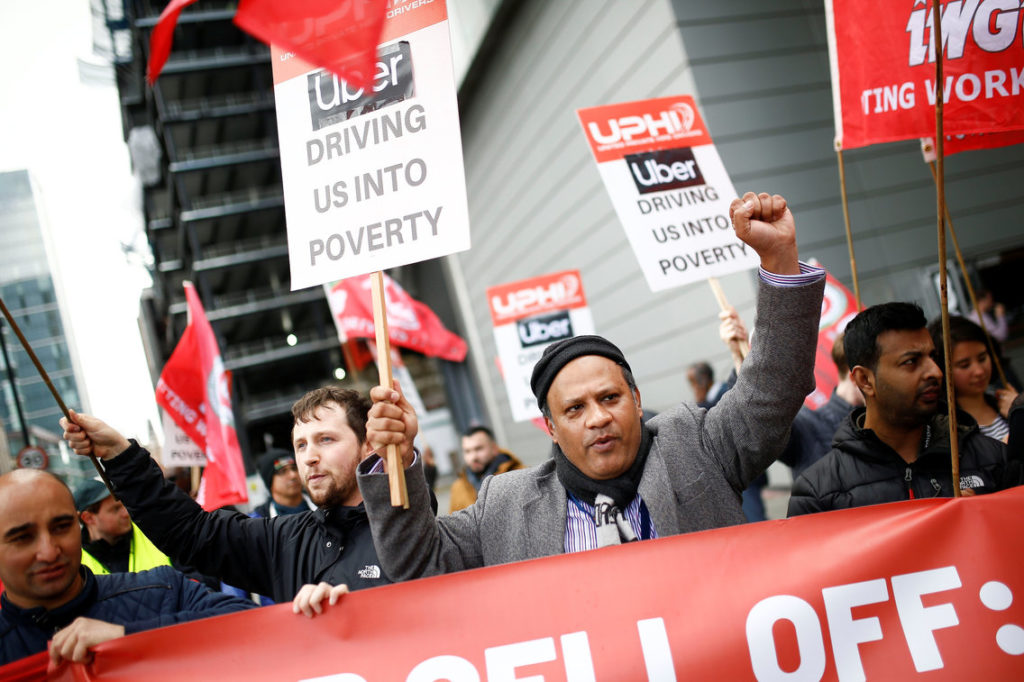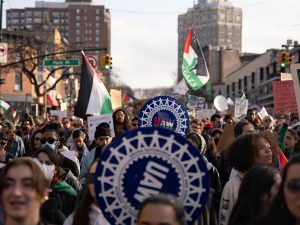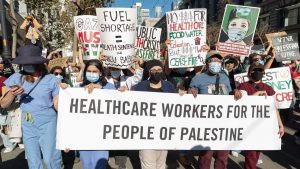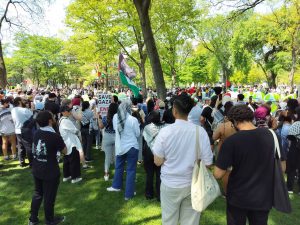Two days before Uber’s initial public offering (IPO) in May, drivers around the world turned off their apps in the first internationally coordinated rideshare strike in history. The labor action gained major media attention as drivers picketed the LA airport and rallied at Uber offices around the world. The call to action, issued by LA Drivers United, protested Uber’s 25% pay cut to its LA drivers. Bourgeois politicians intent on cultivating their own “labor ally” image were compelled to congratulate the striking drivers and lament Uber’s greed. “I stand with the Uber and Lyft drivers going on strike on May 8,” tweeted Bernie Sanders.
In truth the strike was mostly symbolic. A small percentage of drivers participated in the labor action, and Uber’s bottom line was not seriously affected: Most Uber customers had no difficulty obtaining a ride through the apps. But while the strike did not have the numbers or militancy necessary to win significant gains, it succeeded in raising public awareness about the plight of drivers and building a sense of unity between rideshare workers around the world. As a publicized demonstration of international solidarity, the strike was a success.
In New York, drivers staged coordinated slowdowns on the Brooklyn Bridge and other throughways, showing the disruptive power of app drivers. LA strikers drew a crowd of 300 and took the streets. Still, the great potential power of the app workforce was not brought to bear against Uber on a large scale. Much organizing remains to be done to connect the atomized rideshare workforce and build a tradition of solidarity, militancy and organization.
What Would It Take to Unionize the Apps?
From London to Buenos Aires to New York, drivers from the traditional taxi cab industry have vehemently opposed the encroachment of Uber, accurately predicting that rideshare tech will push down wages for everyone. When possible, the international labor movement should oppose Uber/Lyft’s unbridled expansion. Uber’s “independent contractor,” gig-economy model of business undermines organized labor and workers’ rights, throwing greater and greater numbers into poverty and leading to a rash of driver suicides. When the labor movement can ban Uber and co. from operating in a particular city, it should do so. The general trend, however, is toward a drastic expansion of the rideshare industry—often reflecting the failure of accessible public transportation to adequately service the public.
Building a powerful drivers’ union in regions where rideshare is an accomplished fact must be an urgent priority. Most rideshare workers remain cordoned off in their own cars, unaware of drivers’ organizations that already exist. Grassroots organizing is necessary to drastically expand organizations like the New York Taxi Workers Alliance (NYTWA) and LA Drivers United, aiming to build national, and eventually international, unions of drivers. While the NYTWA is chartered with the AFL-CIO, the labor movement as a whole has not committed itself to seriously organizing the rideshare sector from the bottom up.
Industrial unionism provides the best framework through which drivers can organize. If narrow craft distinctions are allowed to divide the various sectors of drivers, as they sometimes do today, we will all lose out. An industry wide union could unite full- and part-time drivers, those who work for Uber, Lyft and other apps, and traditional taxi and livery workers, who have been hardest hit by the rideshare economy. The app giants will attempt to pit one sector of workers against another—our response must be one of class solidarity.
One clear obstacle that must be overcome is the misclassification of drivers (and other workers) as “independent contractors,” a category used by the companies to avoid paying benefits and prevent collective bargaining. This bone of contention continues to be fought out in the courts. In New York, drivers won an important case in which a court ruled that they qualify for unemployment benefits. And in California, the state assembly just passed legislation granting hundreds of thousands of independent contractors employee rights. Nationally, however, the NLRP ruled that Uber/Lyft drivers are contractors, which prevents them from organizing traditional unions.
To build up the power of drivers across the country will require a perspective of class struggle aimed both at the rideshare capitalists and the political establishment. In New York City, it took seven driver suicides before the City Council and the mayor passed legislation to cap the number of new vehicles and to raise pay. While press conferences and symbolic strikes may be capable of winning some reforms in some cities, the vast force of drivers—perhaps 1 million to 2 million in the United States—will not be lifted out of poverty without a larger fight. Drivers have the power to carry out massively disruptive, militant action: We can shut down the streets, the airports, city halls or Uber headquarters. The power of the vast rideshare workforce must be unleashed through concerted organizing, militant action, and a political vision that goes far beyond negotiations with Uber.
The Bubble Getting Ready to Burst
The meteoric rise of Uber as a big capitalist player on the world market is already an accomplished fact. In New York City alone, upwards of 100,000 people work for ridehail app companies like Uber, Lyft, Juno and Via. Internationally, Uber has an estimated 3.9 million drivers, and Lyft 1.4 million, many of whom work for multiple apps simultaneously. Uber and Lyft have a combined market value of over $80 billion, despite massive losses year after year. Uber and co. are building a speculative rideshare bubble that could burst in any number of scenarios.
Uber’s get-rich “endgame” goals include the following: (1) monopolizing the market; (2) getting a stake in the burgeoning driverless vehicle industry; (3) destroying all remnants of the traditional taxi sector; (4) facilitating the complete deregulation of the rideshare industry; (5) making itself “too big to fail” in the eyes of government (ensuring a government bailout if things go south) and (6) growing into fields like nonemergency medical transport (Medicare/Medicaid patients). While the app giants have made progress in many of these areas, much remains uncertain.
In the run-up to the two largest ridehail companies “going public,” for instance, some tech enthusiasts imagined Uber and Lyft would continue their upward trajectory of debt-fueled growth. But the two companies’ recent IPOs were massive disappointments, though certainly no surprise for more farsighted economists who recognize how uncertain the future of rideshare really is. As the Associated Press explained,
While both companies are growing fast, they are losing money just as quickly and face significant challenges to profitability. Last quarter, Uber lost $865 million while Lyft lost $249 million.
Markets Insider called Lyft “wildly unprofitable” while claiming Uber’s recent IPO remains “a disaster in its own right, posting the largest first-day dollar loss of any domestic IPO going back to 1975.”
Uber and co. are major corporate lobbyists, pushing and pleading with politicians to embrace unbridled “Ubernomics.” Winning favor with the political establishment is essential to Uber’s push toward deregulation. But as the recent IPO letdowns suggest, the entire rideshare industry remains extremely volatile, speculative and uncertain. Without a large pool of underemployed workers designated as independent contractors, the Ubernomics business model falls flat. Uber executives, as well as economists, have also remarked that for such companies to succeed, drivers’ pay will have to be cut—otherwise, prices will rise too much for customers, compelling them to seek out alternative transportation. But if drivers are pushed too far into poverty, they will abandon the industry, and the app companies will struggle to meet customer demand. Thus, while Uber and co. could reap massive profit if the stars align for them (their CEOs have already gotten rich), it is also entirely possible that the billion-dollar companies will collapse into bankruptcy in the coming years.
For one thing, new sources of capital investment could dry up, forcing the app giants to cover their own losses in full. Equally devastating for the rideshare capitalists would be if drivers won legal recognition as employees. If Uber, Lyft et al. are forced to pony up the cost of unemployment insurance, workers’ compensation, health insurance options and other benefits owed to employees, their speculative future profits would be even more elusive. Lastly, the future profitability of rideshare capital largely depends on its ability to ruthlessly exploit its drivers with high commissions while providing no job security or benefits. The moment drivers build strong unions, Uber and Lyft’s future profit rates will be jeopardized.
Technology vs. Workers
Marxists have long understood a central contradiction of modern capitalism: that capital continually develops labor-saving technologies that can greatly improve the lives of working people, yet such technologies are often used against the working class. Rather than shortening the workday and allowing people more leisure time, labor-saving advances often throw workers into unemployment or underemployment.
Such is the case with self-driving cars. There are immense potential benefits to the full, computer-based automation of transport. Tech experts have already begun to speculate about the likely drop in personal vehicle ownership that would result from affordable, driverless fleets taxying passengers to their destinations. Such technology could reduce the time and expense necessary for personal transit and take society into a futuristic high-tech world of ease. Just consider: The average American commuter spends over a week every year driving to and from work. Over the course of an individual’s life, a person may spend a whole year or more behind the wheel! Imagine if that time could instead be spent reading, sleeping or doing other leisure activities.
The possibilities of driverless trucks are perhaps even more tremendous. Long-distance shipping remains a major pillar of the world capitalist economy. Without the transportation of goods, there is no profit. The prospect of “driverless truck only” lanes moving cargo across the country, 24 hours a day, looks more and more realistic. Increases in efficiency could be enormous, requiring workers to spend only a fraction of the time accomplishing the old tasks. Workers could work less while producing more.
And yet it is not difficult to imagine how such advances will in reality make many workers’ lives worse. As our productivity increases, capitalism is forcing us to work longer and longer hours. This is not a problem caused by the technology itself, but rather by the capitalist mode of production. We need to divide the available work among everyone, thus drastically reducing the working week for all people. For-profit economics has led us to ruin. It’s time the working class take the reins of society so economic decisions can be democratically decided in the interests of the masses, not the corporate elites.
It’s Time to Nationalize the Tech Giants!
In New York City, a huge metropolis of over 8 million residents, driving Uber has become one of the largest employment sectors, with upwards of 100,000 people “working the apps.” While the live-location algorithms could be put in the service of transporting people more efficiently, in reality it has been used for the opposite purpose: Uber and the other app companies intentionally flooded the streets with drivers, causing massive congestion. Because of the oversaturation of drivers, many cars cruise around the city without a passenger for many hours of the day. Taxi and app drivers alike were compelled to work longer and longer for the same money.
Whether Uber and co. are consciously oversaturating an area with drivers or aiming to replace us all with driverless cars, profit will always be the underlying motive so long as the app companies remain in private hands. App companies do not care about drivers, customers or the environment—speculative profits and cutthroat competition are their reason for their existence. App companies are likely to oppose the construction and maintenance of mass public transit—the most efficient, cost-effective and environmentally beneficial form of transportation—unless they can get a piece of the action. For the simple reason that buses and trains and bikes are bad for rideshare profitability, Uber will oppose them. The app companies want drivers impoverished, atomized and desperate for work. They also want a customer base lacking quality transportation alternatives. In New York, the rise in rideshare is, in significant part, a result of mass dissatisfaction with the deteriorating and outdated subway system.
The wealthy app capitalists have created a massive bubble of speculative investment that could pop at any time. Drivers and the communities we serve should not wait passively for Uber and Lyft’s self-serving business plans to ruin us all. For the last couple of years, Uber and co. have been cutting drivers’ pay rates. Companies that are increasing congestion, impoverishing workers and polluting the environment have no right to wield their power like a club over society.
Instead, all advocates of workers’ rights, affordable mass transit and environmental sustainability should take up the demand to nationalize Uber, Lyft and the rest—under the democratic control of drivers and the community. If the app companies were taken into public ownership, they could be incorporated into a public transit system truly capable of serving the population and providing jobs with living wages. Expropriation would mean “going public” in a much deeper sense of the word.










